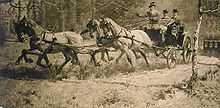Werner von Alvensleben (castle captain)
Werner Ludwig Alvo Graf von Alvensleben , within the family also Alvensleben-Neugattersleben , (* July 20, 1840 in Neugattersleben ; † February 19, 1929 there ) was the owner of the Fideikommiss Neugattersleben, Prussian chamberlain and castle captain of Quedlinburg .
family
Werner von Alvensleben came from the Low German noble family von Alvensleben . He was the son of Ludwig von Alvensleben (1805–1869) and Luise von Trotha from the Schkopau family (1811–1893) and had been married to Anna von Veltheim (1853–1897) from Ostrau since July 20, 1871 . The marriage gave birth to five sons and two daughters, including the businessman and politician Werner von Alvensleben (1875-1947), the Canadian entrepreneur Gustav Konstantin (Gustin) von Alvensleben (1879-1965) and his successor in Neugattersleben and president of the Bodo men's club Count of Alvensleben (1882–1961). Two other sons died in the First World War. The widow of his eldest son Joachim (1872–1914) Armgard von Alvensleben , b. von Knebel-Döberitz (1893–1970) became abbess of the Stift zum Heiligengrabe monastery in 1938 and, after the war, general manager of the Evangelical Station Mission in Germany.
Life
Werner von Alvensleben attended grammar school in Bernburg (Saale) and the forestry academy in Tharandt , served in the army for a few years and in 1868 took over the management of his father's property in Neugattersleben, initially as a tenant and, after his father's death, as the owner. As such, he developed a comprehensive entrepreneurial activity outside of agriculture. So he took over the sugar factory built by his father, which he closed in 1880 in order to take a share in the sugar factory in neighboring Hohenerxleben . He modernized the mining of lignite in the Luise-Hedwig mine, opened a lime works, tried - albeit unsuccessfully - to develop potash deposits and enlarged the water mill for generating electricity. A potato flake factory was built in 1910 and a drying plant for beet leaves was built in 1916.
In Neugattersleben he carried out a reconstruction and extension of the palace and redesigned the park. Under his church patronage, the churches in Löbnitz (1886) and Hohendorf (1887–1889) were rebuilt, as well as a hospital.
In terms of sport, he excelled as one of the best four-in-hand drivers of his time and as such won numerous awards. At the age of 73, he successfully participated in a tournament on the occasion of the 25th anniversary of the reign of Kaiser Wilhelm II in the Berlin stadium. He was a frequent guest on the hunts in Neugattersleben and in 1889 was the godfather of the youngest daughter Wilhelmine. When the housewife Anna, geb. von Veltheim, died in 1897, the emperor donated a grave monument, which he designed himself and which he was personally present at the unveiling.
Further honors followed: he was appointed chamberlain and castle captain of Quedlinburg , elevated to the rank of count on the day of coronation in 1901 and he was given the title of excellence in 1913. In addition, he received numerous awards, including the star for the Order of the Red Eagle, 2nd class. He was also a legal knight of the Order of St. John . After the First World War, in old age, he gradually withdrew from the management of his businesses and handed them over to his fourth son, Bodo.
literature
- Wilhelm Kamlah: The history of Hohendorf, Neugattersleben, Löbnitz with a chronicle . Eisleben 1907.
- Hellmut Kretzschmar : Historical news of the Alvensleben family since 1800 . Burg 1930, pp. 65–67.
- Ernst Krause: Memories of Neugattersleben . Unpublished manuscript (219 pages). Hall 1935.
Web links
| personal data | |
|---|---|
| SURNAME | Alvensleben, Werner von |
| ALTERNATIVE NAMES | Alvensleben-Neugattersleben, Werner Ludwig Alvo Graf von (full name) |
| BRIEF DESCRIPTION | Owner of Fideikommiss Neugattersleben, Prussian Chamberlain and Castle Captain of Quedlinburg |
| DATE OF BIRTH | July 20, 1840 |
| PLACE OF BIRTH | Neugattersleben |
| DATE OF DEATH | February 19, 1929 |
| Place of death | Neugattersleben |

